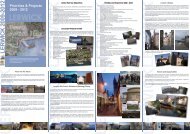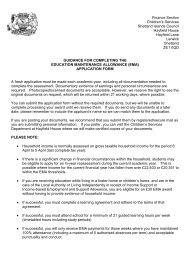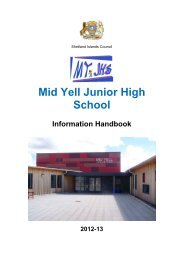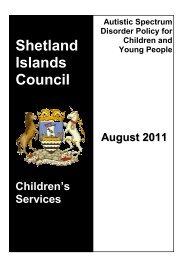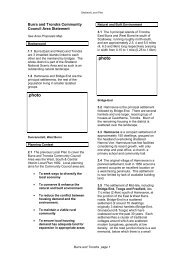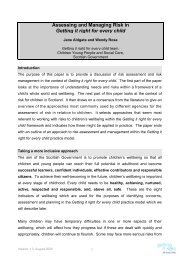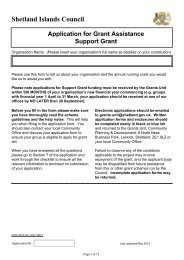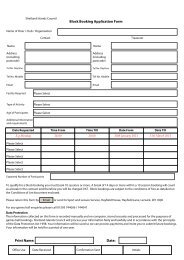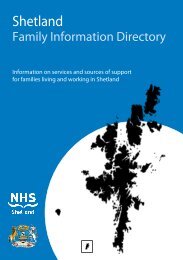Shetland Local Landscape Designation Review: Final Report
Shetland Local Landscape Designation Review: Final Report
Shetland Local Landscape Designation Review: Final Report
Create successful ePaper yourself
Turn your PDF publications into a flip-book with our unique Google optimized e-Paper software.
Candidate <strong>Local</strong> <strong>Landscape</strong> Area 9: No Ness and Mousa<br />
Location and boundaries:<br />
This narrow headland and adjacent island lies west of Sandwick on the southern Mainland,<br />
approximately midway between Sumburgh Head and Lerwick. The land boundary of the area<br />
follows the minor road between Sandwick and Sand Lodge, separating the undeveloped peninsula<br />
from the more settled landscape around Sandwick.<br />
Key characteristics:<br />
<br />
<br />
<br />
<br />
An undeveloped headland within the most densely settled part of <strong>Shetland</strong><br />
Prominent position on the south Mainland coast, with long visual links<br />
Important cultural landmarks<br />
Jagged rocky foreshores and sandstone strata<br />
<strong>Designation</strong> statement:<br />
The narrow headland of No Ness extends south and west from the southern Mainland,<br />
separating Sand Wick to the west from Mousa Sound to the east. The peninsula is very sparsely<br />
settled, in contrast with the more densely settled area around Sandwick and Houlland to the<br />
west. The long headland forms an important part of the setting of the small, traditional hamlet of<br />
Sandwick at the head of the deep bay.<br />
No Ness overlooks the small uninhabited island of Mousa to the east. Both ness and island are<br />
surrounded by an exposed rocky coastal edge, displaying an intricate pattern of sandstone strata.<br />
The low lying island is subtly rounded, almost separated into smaller islands where the landform<br />
dips. The tidal lagoons of East and West Pool, connected by rocky sounds, are attractive<br />
features, hidden from the Mainland. Jagged rocks jut from the foreshore, and rock outcrops<br />
extend into the grassy interior. The island is a popular visitor destination, known for its<br />
population of storm petrels. It is also highly visible from the settled parts of the Mainland, and<br />
from the main A970, as is No Ness.<br />
Signs of historic settlement include the impressive Mousa Broch, the most intact surviving<br />
example of this Iron Age building type, which is strongly associated with the Northern Isles.<br />
Facing Mousa Broch are the remains of its sister, the Broch of Burraland on No Ness. Together,<br />
these two remnants offer a glimpse of the <strong>Shetland</strong> past, where sea transport was more<br />
important than land. Long views from the headland allow long views along the seaways north to<br />
Bressay and Noup of Noss and south to Sumburgh Head.<br />
Development guidelines:<br />
<br />
<br />
<br />
Seek to protect the largely undeveloped nature of the headland, as a contrast to the settled<br />
land to the west<br />
Promote responsible access and understanding of the area’s past<br />
Seek to protect the setting of the important group of historic buildings and Sand Lodge<br />
<strong>Shetland</strong> Islands <strong>Local</strong> <strong>Landscape</strong> <strong>Designation</strong> <strong>Review</strong><br />
Land Use Consultants<br />
<strong>Final</strong> <strong>Report</strong> 70 October 2011



